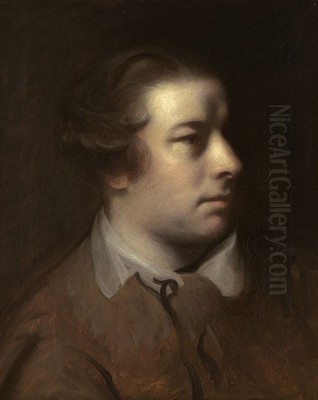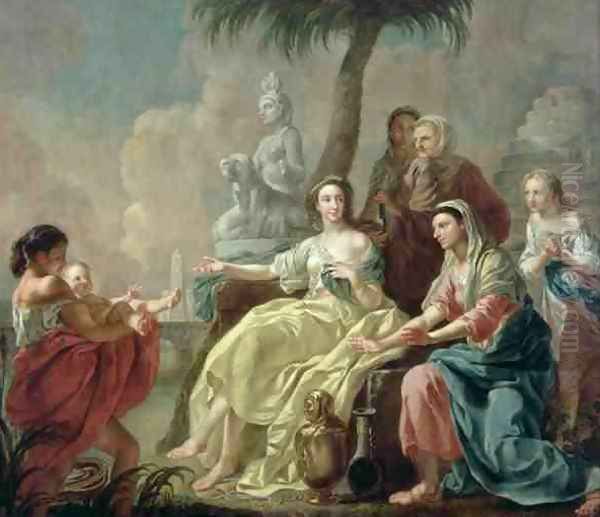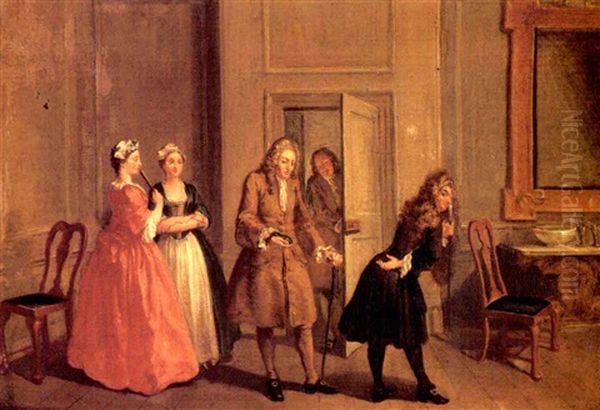
Francis Hayman stands as a significant, albeit sometimes overlooked, figure in the landscape of 18th-century British art. Born in Exeter, Devon, in 1708, and passing away in London in 1776, Hayman's career spanned a crucial period of development for the arts in Britain. He was a versatile artist, proficient as a painter of historical subjects, portraits, and the newly popular 'conversation pieces'. Furthermore, he excelled as a scene painter for the theatre, a prolific book illustrator, an influential teacher, and ultimately, a key figure in the establishment of the Royal Academy of Arts. His work and influence connect the robust narrative tradition of William Hogarth with the burgeoning elegance and professionalism embodied by the Academy's leading lights, such as Sir Joshua Reynolds.
Early Life and Artistic Formation
Francis Hayman's journey into the world of art began in the West Country, in the cathedral city of Exeter. While details of his earliest years are sparse, it is known that he received his initial artistic training under the tutelage of Robert Brown (d. 1753). Brown was primarily known as a decorative painter, often collaborating with architects on interior schemes. This grounding in decorative work, often executed on a large scale, may have provided Hayman with valuable experience in handling compositions and working efficiently, skills that would prove useful in his later career as a scene painter and creator of large historical canvases.
Like many ambitious young artists of the time, Hayman recognized that London was the epicentre of artistic opportunity and patronage in Britain. He relocated to the capital, seeking to establish himself within its competitive but vibrant art scene. The precise date of his move is uncertain, but by the 1730s, he was beginning to make his mark. London offered access to fellow artists, potential patrons, print publishers, and the stimulating environments of the theatre and the burgeoning literary world, all of which would shape Hayman's diverse career path.
Theatrical Beginnings: Scene Painting

One of Hayman's earliest significant roles in London was as a scene painter for the city's theatres. He is documented as having worked at the Goodman's Fields Theatre and, more notably, at the prestigious Drury Lane Theatre during the tenure of actor-manager David Garrick, who became a friend. Scene painting in the 18th century was a demanding craft, requiring artists to create large, visually striking backdrops quickly and effectively. These paintings needed to establish mood, location, and dramatic atmosphere, often employing techniques of perspective and illusionism.
This theatrical work undoubtedly honed Hayman's skills in composition, large-scale execution, and narrative suggestion. The need to convey stories and emotions visually on stage paralleled the demands of history painting and illustration. His immersion in the theatrical world also brought him into contact with playwrights, actors, and designers, enriching his understanding of dramatic narrative. Interestingly, Hayman even took to the stage himself on occasion, reportedly playing a minor role in a production of Milton's Comus. This direct involvement underscores his deep connection to the dramatic arts of his time.
St Martin's Lane: A Crucible of Talent
During the 1730s and 1740s, before the formal establishment of the Royal Academy, the area around St Martin's Lane was the unofficial centre of London's art world. Several drawing schools and academies operated here, providing crucial training and a meeting place for artists. Hayman established his own studio in St Martin's Lane and became associated with the St Martin's Lane Academy, a key institution run informally by artists like William Hogarth.
This environment was a melting pot of ideas and influences. Hayman worked alongside Hogarth, whose robust realism and satirical narratives were defining a distinctly British approach to art. He also associated closely with the French engraver and draughtsman Hubert-François Gravelot, who had settled in London in 1732. Gravelot was instrumental in introducing the lighter, elegant aesthetics of the French Rococo style to British artists, particularly through his refined drawing techniques and book illustrations. Hayman absorbed these influences, blending Hogarth's narrative vigour with Gravelot's Rococo grace, and himself became a respected teacher within this milieu.
The Vauxhall Pleasure Gardens: A Public Spectacle
Perhaps Hayman's most famous and ambitious project began in the early 1740s when he was commissioned by Jonathan Tyers, the proprietor of the Vauxhall Pleasure Gardens, to produce a series of large decorative paintings. Vauxhall was one of London's most popular public entertainment venues, offering music, dining, and promenades in a beautifully landscaped setting. Hayman's paintings were designed to adorn the supper-boxes, the small pavilions where visitors dined.

This commission was vast in scale, with dozens of paintings attributed to Hayman and his studio over the years. The subjects were diverse, initially focusing on scenes of contemporary life, popular games, and rural pastimes, such as depictions of May Day celebrations (including the work sometimes known as The Dancing Milkmaids or The Milkmaid's Garland), children playing games like see-saw and leap-frog, and scenes involving fortune-tellers or pastoral figures. These works captured the cheerful, leisurely atmosphere of the Gardens and reflected the Rococo taste for light-hearted, decorative themes, effectively translating the French fête galante into a distinctly English idiom.
Later, particularly around 1760, Hayman contributed more serious historical subjects to Vauxhall, celebrating recent British victories in the Seven Years' War. These large canvases, depicting events like the Conquest of Quebec or Lord Clive meeting Mir Jafar after the Battle of Plassey, showcased Hayman's abilities as a history painter on a grand scale. The Vauxhall paintings were seen by thousands of Londoners and visitors, significantly boosting Hayman's public profile and cementing his reputation as a leading decorative and historical painter of his generation.
Master Illustrator: Engaging with Literature
Alongside his painting career, Hayman became one of the most sought-after book illustrators in Britain during the mid-18th century. The rise of the novel and an expanding reading public created a demand for illustrated editions of popular and classic texts. Hayman's ability to translate narrative into compelling visual images made him a natural fit for this work. His background in scene painting and his association with Hogarth's narrative art informed his approach.
In the early 1740s, he provided influential illustrations for Samuel Richardson's immensely popular novel Pamela; or, Virtue Rewarded. These images helped shape the public's visualization of the novel's characters and key scenes. He also contributed illustrations to editions of John Milton's epic poems Paradise Lost and Paradise Regained, and to periodicals like The Spectator.
A particularly significant commission was for Sir Thomas Hanmer's lavish edition of the works of William Shakespeare, published in Oxford in 1743-44. Hayman designed the majority of the thirty-six plates, often collaborating with Hubert Gravelot, who engraved many of the designs. Hayman's Shakespeare illustrations are notable for their dramatic flair and interpretive depth. He didn't merely depict the scenes as described; he often added his own interpretive nuances. For instance, his illustration for the play-within-a-play scene in Hamlet emphasizes King Claudius's guilt and discomfort. In Macbeth, he focused on Lady Macbeth's psychological intensity. His depiction of the final scene in Romeo and Juliet uses details like a broken door to symbolize the tragic failure of their union. Other plays he illustrated included Antony and Cleopatra, The Tempest, and King Lear. These illustrations were highly influential and contributed significantly to the visual culture surrounding Shakespeare in the 18th century.
Portraiture and the Conversation Piece
While renowned for his historical and illustrative work, Hayman was also an accomplished portrait painter. He worked within the emerging genre of the 'conversation piece' – informal group portraits showing families or friends interacting in domestic or garden settings. This genre was popularized by artists like Hogarth and Arthur Devis. Hayman's conversation pieces often display a Rococo lightness and elegance, depicting the comfortable lives of the rising merchant and professional classes. He moved away from the stiff formality that characterized much earlier British portraiture under artists like Sir Godfrey Kneller and Michael Dahl, favouring more relaxed poses and settings.
His individual portraits also often possess a lively charm and characterisation. A notable example is the Portrait of a Jaunty Young Woman in a Feathered Hat (c. 1745-50), which captures a sense of fashionable informality. While perhaps not reaching the psychological depth of his pupil Gainsborough or the grandeur of Reynolds, Hayman's portraits were well-regarded in their time and contributed to the development of a more naturalistic and engaging style of portraiture in Britain, absorbing influences from French artists like Antoine Watteau and François Boucher but adapting them to British tastes.
Nurturing the Next Generation: Hayman as Teacher
Hayman's role as an educator was crucial in shaping the next generation of British artists. His teaching activities began informally at the St Martin's Lane Academy, where he was considered one of the leading instructors alongside Gravelot. He provided practical training in drawing and painting at a time when formal art education infrastructure was lacking in London.
His most famous pupil was undoubtedly Thomas Gainsborough, who studied with Hayman in London during the 1740s. While Gainsborough would develop his own unique and brilliant style, Hayman's influence can be discerned, perhaps in Gainsborough's early handling of figures, his landscape backgrounds, and his general grounding in the Rococo aesthetic. Hayman's emphasis on drawing and his connection to the French style via Gravelot likely provided a valuable foundation for the young Gainsborough.
Other artists who are believed to have studied with Hayman include Nathaniel Dance-Holland, who became a successful portraitist and history painter, the portrait painter Mason Chamberlin, and possibly Lemuel Francis Abbott. Through his teaching, Hayman played a vital part in transmitting skills and artistic ideas, contributing significantly to the growing confidence and competence of the British school of painting in the mid-18th century. James Charpentier and Charles Graham are also mentioned as students in some accounts, reflecting his active role as an instructor.
Founding the Royal Academy of Arts
The culmination of efforts by artists like Hayman, Hogarth, Reynolds, and others to raise the status and standards of art in Britain was the foundation of the Royal Academy of Arts in 1768, under the patronage of King George III. Hayman was a prominent figure in the movement to establish the Academy and was duly named one of the thirty-six Foundation Members.
This was a landmark event in British art history, providing a formal institution for exhibition, education, and the promotion of artistic excellence. The founding members included the leading artists of the day across various fields: Sir Joshua Reynolds was elected the first President, Benjamin West (history painting), Angelica Kauffman and Mary Moser (two female founders, history and flower painting respectively), William Chambers (architect), Paul Sandby (watercolourist), Francesco Zuccarelli (landscape painter), and George Stubbs (animal painter), among others.
Hayman's respected position within this group was further recognized by his appointment as the Academy's first Librarian in 1770, a post he held until his death. This role suited his scholarly and literary interests, demonstrated through his extensive work as an illustrator. He regularly exhibited paintings, primarily historical and literary subjects, at the Academy's annual exhibitions during its early years, contributing to the institution's prestige and public profile.
Later Years, Challenges, and Legacy
In his later career, Hayman continued to paint and remained active within the Royal Academy. However, he faced some disappointments. His ambition to establish himself further as a premier history painter suffered a setback when he failed to secure a commission for large-scale decorative paintings for the new Houses of Parliament. This, combined with reported financial difficulties, seems to have cast a shadow over his final years. Gout also increasingly afflicted him.
Francis Hayman died at his home in Dean Street, Soho, London, on February 2, 1776. He left behind a significant body of work across multiple genres. While later generations sometimes unfairly compared him to his brilliant pupil Gainsborough or the dominant figure of Reynolds, Hayman's contribution to 18th-century British art is undeniable and multifaceted.
His legacy rests on several pillars. He was a pioneer in large-scale decorative history painting in Britain, most notably through his Vauxhall commissions. He was one of the most important book illustrators of his time, skillfully interpreting major literary works and contributing to the visual culture of the era. He helped popularize the informal conversation piece and brought a Rococo elegance to British painting. He was a vital link as a teacher, transmitting skills and influencing key artists like Gainsborough. Finally, his role as a Foundation Member and the first Librarian of the Royal Academy underscores his central position in the professionalization and elevation of the arts in Great Britain. He worked alongside and influenced a wide range of artists, including contemporaries like Allan Ramsay and Joseph Highmore, and helped pave the way for the flourishing of British art in the later 18th century.
Conclusion
Francis Hayman emerges from the historical record as a versatile, industrious, and highly influential figure in the British art world of the 18th century. From the stages of Drury Lane to the supper-boxes of Vauxhall Gardens, from the pages of Richardson and Shakespeare to the founding rooms of the Royal Academy, Hayman's presence was felt. He successfully navigated the transition from the era of Hogarth and the informal St Martin's Lane Academy to the more structured, ambitious world of the Royal Academy under Reynolds. As a painter, illustrator, designer, and teacher, he played a crucial role in shaping the styles, genres, and institutions that would define British art for generations to come. Though perhaps lacking the singular genius of a Hogarth or a Gainsborough, Francis Hayman was undoubtedly a cornerstone upon which much of their success, and the success of the British school, was built.